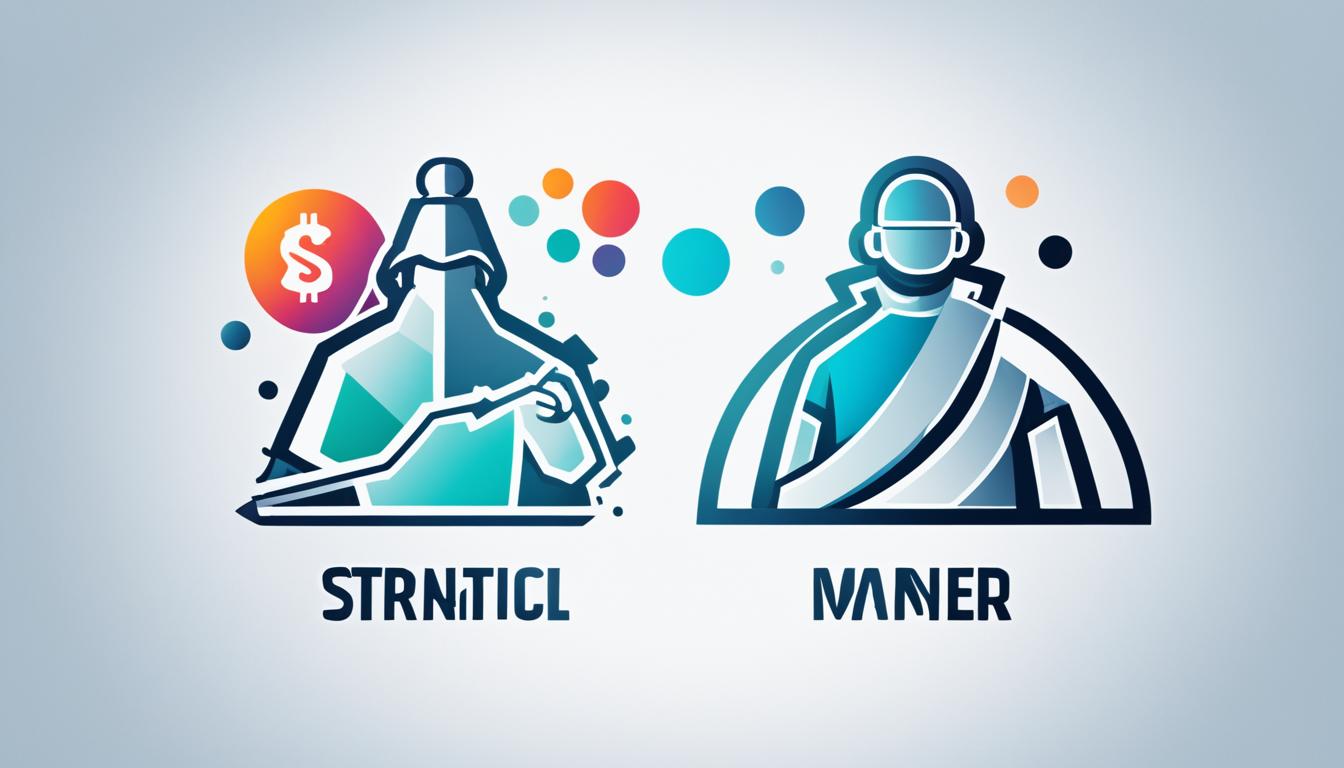Mass marketing is a powerful way to reach everyone, not just certain groups. It uses big distribution networks and mass media to grab a wide audience’s attention. It is very effective in making people aware of brands and boosting sales in today’s market.
We will look into what mass marketing is, its pros and cons, and examples of successful campaigns. This will be helpful for marketers and business owners planning their marketing approaches. It gives valuable insights into mass marketing.
Key Takeaways:
- Mass marketing appeals to an entire market rather than specific target groups.
- It uses mass distribution and mass media to reach a wide audience.
- Advantages of mass marketing include cost-efficiency and increased brand awareness.
- Disadvantages include the risk of changes in the market and consumer preference for targeted marketing.
- Real-world examples of successful mass marketing campaigns include toothpaste ads, deodorant ads, and the Dawn dishwashing detergent ad.
What is Mass Marketing?
Mass marketing is a way to target everyone instead of just a few. It’s about making products that many people will like. This strategy is different from niche marketing, which focuses on specific groups.
This approach uses mass distribution and media to reach as many folks as possible. The idea is to make the brand known to everyone. By selling “must-have” items at lower prices, companies hope to attract lots of customers.
Mass distribution means putting products in many places, like stores and online. This makes it easy for everyone to buy them. Having products available in many spots helps reach the whole market.
Mass media includes TV, radio, newspapers, and online sites. These channels help companies spread the word to lots of people at once. This increases the chance of people seeing the products and becoming interested.
By using both mass distribution and media, companies can reach a wide audience. They can use creative ads, interesting content, or partnerships to get into the market. This way, businesses can make a strong impact.
Advantages of Mass Marketing
One advantage of mass marketing is the
scope
and
cost-efficiency
of advertising big. Through print, social media, and broadcasting, companies can reach thousands or millions. This way, many people learn about their products.
Mass marketing helps companies spread their message far and wide. They use mass media and distribution to become well-known. This makes it hard for new competitors to compete.
Also, mass marketing saves money on advertising. By talking to lots of potential customers at once, companies spend less per person. This means they can use their money in other important business areas.
In the end, mass marketing’s big pluses are reaching more people, making the brand well-known, and saving on ads. With good mass marketing plans, companies can do well against others.
Disadvantages of Mass Marketing
Mass marketing has benefits but also downsides that must be considered. These drawbacks can guide businesses in their marketing strategies. Here are the main cons of mass marketing:
1. **Changes in the Market**
Mass marketing is like putting all your eggs in one basket. If consumer tastes change or the economy drops, it’s hard for companies, especially small ones, to adapt. They may struggle with market shifts.
2. **Limited Targeting**
Mass marketing can’t easily target specific groups. It tries to reach as many people as possible. But today, consumers want messages that fit their unique interests. This makes mass marketing less appealing to them.
3. **Decreased Efficiency**
Mass marketing isn’t very efficient in engaging a specific audience. With so many ads everywhere, it’s tough for mass campaigns to stand out. This can waste resources and lower profits.
4. **High Competition**
With mass marketing, companies face stiff competition. Everyone targets a similar large audience. This makes it hard for brands to be unique. It can lead to a race to the bottom in prices.
5. **Limited Engagement and Brand Loyalty**
Mass marketing lacks a personal touch. This makes it hard to connect deeply with customers. Without this connection, building brand loyalty and retaining customers is tougher. It misses the chance to turn customers into advocates.
Although mass marketing reaches many people at a low cost, it’s crucial to recognize its limitations. To overcome these issues, companies might blend in targeted marketing strategies. These approaches allow for more personalized messaging and better engagement with specific audience segments.
Mass Marketing Examples
Over the years, many brands have launched mass marketing campaigns to attract a large audience. They have used different ways to promote their products and become memorable to people. Let’s look at some memorable mass marketing examples.
Toothpaste Ads
Crest and Colgate are famous toothpaste brands. They’ve used mass marketing to show their products. Through TV commercials, ads in magazines, and online, they’ve reached many people. They have become known as reliable oral care brands because of their constant ads.
Deodorant Ads
Deodorant ads use mass marketing too. Secret, for instance, has made ads that many people like. Their catchy phrases and relatable stories have made them popular. They are seen as the top choice for staying fresh.
Dawn Dishwashing Detergent Ad
The Dawn dishwashing ad is a great example of mass marketing. It shows touching commercials about saving wildlife. This makes people see Dawn as effective and caring, which wins their loyalty.
| Brand | Product | Marketing Channels |
|---|---|---|
| Crest | Toothpaste | Television commercials, print advertisements, online campaigns |
| Colgate | Toothpaste | Television commercials, print advertisements, online campaigns |
| Secret | Deodorant | Television commercials, print advertisements, online campaigns |
| Dawn | Dishwashing detergent | Television commercials, online campaigns |
Difference Between Mass Marketing and Target Marketing
Marketing strategies often include mass marketing and target marketing. Though both seek to attract customers, they take different paths.
Mass Marketing
Mass marketing targets a wide audience with one message. It’s a broad approach, aiming to reach as many as possible.
Mass marketing uses various channels to get its message across to numerous people. It’s suited for widely appealing products.
This method doesn’t focus on specific groups. It crafts a message that appeals to many by showing product advantages.
Target Marketing
In contrast, target marketing hones in on a select audience. Target marketing crafts ads for specific groups’ needs and interests.
This strategy involves detailed market research. It identifies the target’s traits and desires for more personalized ads.
Target marketing leads to ads that resonate more with potential buyers. This specificity enhances ad effectiveness and resource use.
The main difference between mass marketing and target marketing is focus. Mass marketing strives for wide appeal, while target marketing customizes messages for particular demographics. The best approach depends on the campaign’s goals.
tr>
| Mass Marketing | Target Marketing |
|---|---|
| Untargeted and undifferentiated | Targeted and personalized |
| Aims to reach a broad audience | Focuses on a specific demographic |
| Uses mass distribution and mass media | Tailors advertisements to the target audience |
| Creates a single message for all | Addresses the unique needs of the target audience |
Common Uses of Mass Advertising Today
Mass advertising is a key element in marketing strategies today. It uses both old-school and digital ways to connect with a lot of people. Let’s dive into how mass advertising is used in the current market.
Traditional Mass Advertising
Traditional channels like TV, radio, print, and billboards are still very effective. TV ads mix visuals and sound to grab viewers’ interest. Radio ads engage listeners with compelling audio stories.
Print ads can focus on certain groups of people in newspapers and magazines. Billboards get noticed in places where lots of people go.
Digital Mass Advertising
Digital marketing’s growth has made mass advertising reach further. It’s more cost-effective too. Now, using social media, websites, and emails, businesses can introduce their offerings to a global audience.
Display ads, online search marketing, and video ads are key ways they do this. These strategies help in making a brand more visible and grabbing the attention of potential buyers.
One big way digital mass ads are used is in brand awareness. These efforts use the wide net of digital spaces to introduce a brand to lots of people. They aim to create a lasting image in the consumer’s mind.
By using both traditional and digital mass advertising, companies can make the most of mass marketing. This blend helps in making a brand more seen, getting a bigger market slice, and growing the business.
Mass Marketing Strategies
In mass marketing, companies use different tactics to reach many people and boost their brand. They often use the shotgun approach and guerrilla marketing strategies.
Shotgun Approach
The shotgun approach spreads the message wide to hit as many as possible. It uses many media channels like TV, radio, and online ads. The aim is to get the word out everywhere.
This way, it tries to grab the attention of many potential buyers. By showing the ad often, the company hopes to interest people in what they sell.
Guerrilla Marketing
Guerrilla marketing goes for the unexpected to grab attention. It’s about creating campaigns that stick in people’s minds.
This approach values creativity and surprise. Tactics include flash mobs or street art to get people talking about the brand.
With guerrilla marketing, businesses aim to make their brand unforgettable. This is done through standout advertising.
Both shotgun and guerrilla marketing get the word out effectively. While the shotgun approach reaches many quickly, guerrilla marketing makes a lasting impact. Using both, companies can appeal to more people in memorable ways.
| Mass Marketing Strategies | Shotgun Approach | Guerrilla Marketing |
|---|---|---|
| Definition | Aims to reach as many people as possible through various media channels | Focuses on creating unique and memorable campaigns to capture attention |
| Target Audience | Wide audience | General audience |
| Key Characteristics | Broad reach, high frequency of exposure | Unconventional, creative, eye-catching |
| Benefits | Reaches a large audience, increases brand exposure | Captures attention, creates memorable brand experiences |
The Benefits of Mass Marketing
Mass marketing helps businesses reach more people and boost brand awareness. By using this strategy, companies can target a vast customer base. This leads to more visibility and possible sales increase.
One of its main perks is reaching a wider audience. Using mass distribution channels like TV, radio, print media, and the internet allows businesses to share their message with many. This wide exposure brings in new customers and boosts sales chances.
Mass marketing is also more budget-friendly than targeted marketing. Instead of making special campaigns for different groups, businesses send one message through many channels. This saves money and makes the strategy cost-effective for spreading advertising power.
It’s great for making more people aware of a brand. With a consistent message sent to many, businesses can build a stronger brand identity. This makes customers more likely to remember and trust the brand when buying something.
Additionally, mass marketing can keep competitors away. A strong marketing presence makes it hard for new companies to enter the market. This can give companies a lasting advantage, helping them keep a large market share and their customers.
Mass marketing has many benefits, including reaching more people, being cost-effective, boosting brand awareness, and keeping competitors at bay. Through mass distribution, businesses can connect with more consumers, strengthen their market position, and achieve long-term success.
Questions of Quality in Mass Marketing
Mass marketing often brings up quality concerns. It aims to reach a wide audience and sell in large quantities. By using lower-quality materials and planned obsolescence, it keeps costs down and pushes for frequent replacements.
Planned obsolescence means making products that don’t last long on purpose. Many items like appliances or electronics are sold this way. People end up replacing them when they wear out or get old.
This method makes people wonder about the quality of what they buy. They think about whether the products are made to last. Or if they’re meant to be thrown away soon. The use of cheap materials makes these worries even bigger.
It’s important for companies to find a good balance. They need to keep making things efficiently but also keep the quality up. Not all mass-produced items are bad. But buyers should know what they might be giving up with these products.
Examples of Quality Concerns in Mass Marketed Products
Here are some examples where quality issues show up in mass-produced items:
- Electronics with short lifespans due to planned obsolescence
- Clothing items that quickly lose their shape or color
- Home appliances that break down shortly after the warranty expires
These examples don’t mean every mass-produced product is poor quality. But they do suggest buyers should think carefully about their purchases. It’s wise to consider the long-term value of what they buy.
| Concerns | Solutions |
|---|---|
| Planned obsolescence | Companies can offer extended warranties or design products for easier repair to address planned obsolescence concerns. |
| Substandard materials | Implementing stricter quality control measures and sourcing higher-quality materials can help improve the overall quality of mass marketed products. |
| Durability | Companies can invest in thorough product testing and consumer feedback to ensure their mass marketed products are durable and reliable. |
The Role of Technology in Mass Marketing
Technology has changed mass marketing greatly by using digital channels. The start of the internet and online platforms has made mass marketing more effective and wide-reaching.
It lets marketers reach more people easily and save money. They can make ads and campaigns that connect with many consumers. This leads to more people knowing about the brand and more customer activity.
One main benefit of technology in mass marketing is understanding consumer data. This data helps marketers learn what consumers like and buy. This way, they can create better messages and offers.
Also, technology creates new ways for brands to talk to their audience. Through social media, emails, and apps, brands can directly connect with customers. This builds stronger relationships and loyalty to the brand.
Technology’s effect on mass marketing shows in many industries. For example, the retail world now uses e-commerce to sell worldwide. Also, the entertainment world promotes its work through streaming and online ads.
In the end, technology is crucial for mass marketing’s success today. It helps marketers reach more people, understand their audience better, create deeper connections, and grow their business.
Conclusion
Mass marketing can be a great tool for companies to introduce new products and boost their brand. It targets a wide audience through different ways. This helps companies get a lot of attention and reach many people.
But it’s important for businesses to really think about if people want their products. They need to pick the best marketing plans for them. It’s about knowing what customers like, keeping up with trends, and watching competitors.
Getting the marketing strategy right is key. A good plan can help a company meet its goals and do well. It has to be well-thought-out and cover everything needed for success.
Even though mass marketing has its perks, it shouldn’t be the only method used. Mixing it with campaigns that talk directly to specific groups of people can make things better. This way, businesses can meet a wide range of customer needs.
Businesses must also keep improving their marketing methods. This lets them deal with changes in the market and stay on top. By doing so, they can keep leading the competition.



